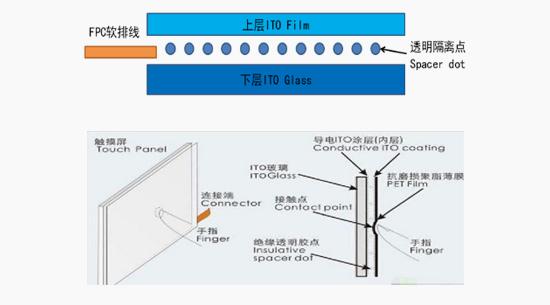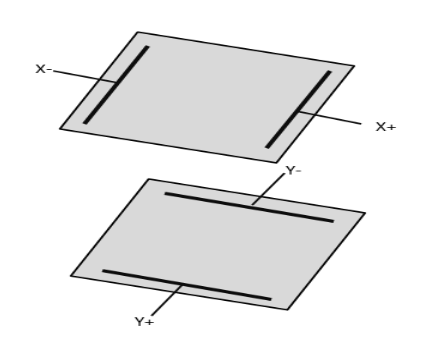Resitive Touch Panel
Resistive touch panel, also referred to as RTP, is a voltage sensor that converts the physical position of the touch point (X,Y) in the touch area into the X coordinate and Y coordinate. Resistance panel can be divided into four wire, five wire, seven wire, eight wire, etc., four wire and five wire resistance panel are commonly used
RTP structure

The RTP is mainly divided into two ITO layers, separated by the middle spacer dots . When the fingers press, two conductive ITO coating that are usually insulated from each other will be connected at the contact point , with one side of conductive layer on the Y axis for 5 v uniform electric field, the detecting bottom layer’s voltage is from zero to A nonzero, then the controller can detect the connection,and confirm Y coordinates through A/D conversion and compared with 5 v voltage value. Same for the X coordinate.
Four-wire RTP
A four-wire RTP contains two resistive layers. Silver paste wires are printed on the left and right sides of the upper layer, and silver paste wires are printed on the upper and lower sides of the lower layer. To obtain the X-axis coordinates, the upper layer is set to 0V on the left and Vref on the right. The lower layer is connected to the ADC. After pressing and touching, a measurement value can be obtained.
To obtain the Y-axis coordinates, the upper layer is offset to Vref and the lower to 0V. Connect the ADC input to the left or right side of the line, when the upper and lower layers connect, it can be measured.

Five-wire RTP
A five-wire RTP uses a resistive layer and a conductive layer. The conductive layer has a contact, which is usually on its side edge. The resistive layer has a contact at each of its four corners.
To get the X-axis coordinates, offset the upper and lower left corners to Vref and ground the upper and lower corners. Because the left and right angles are the same voltage. In order to obtain the Y-axis coordinates, the upper left and upper right corner are offset to Vref, and the lower left and right corners are offset to 0V, basically similar to the method used in the four-wire RTP.
Advantages and Disadvantages of RTP
Advantages:
1. it’s in a completely isolated external working environment, no risk of dust, water vapor pollution.
2. can be touched by any object, to achieve human-computer interaction.
3. RTP’s accuracy depends on A/D conversion accuracy, it is not affected by the external environment, has more stabel performance.
4. RTP technology is mature, and with simple design, low cost.
Disadvantages: mainly limited by the structure, the upper layer of film is easy to be scratched and scraped, and it’s multi-layer structure that has poor light transmission.
Topland Electronics (H.K) Co., Limited
Tel:+86-0755-26487325
Fax:+86-0755-26487326
E-Mail:info@topland.com.hk
About TOPLAND
TOPLAND is committed to be a work leader of intergrated products and solutions of photoelectric display. Through the technical precipitation of backlight, touch screen and LCD products, we have the ability to provide customers with a complete set of technical solutions and services in the industry, and provide interface support for the interconnection of all things in the future.
Last:What is the difference between TN, VA and IPS screens? The most basic display selection method
Next:no more
Topland Electronics (H.K) Co. Ltd All rights reserved 粤ICP备11098054号
By continuing to use the site,you agree to the use of cookies.Read MoreACCEPT







